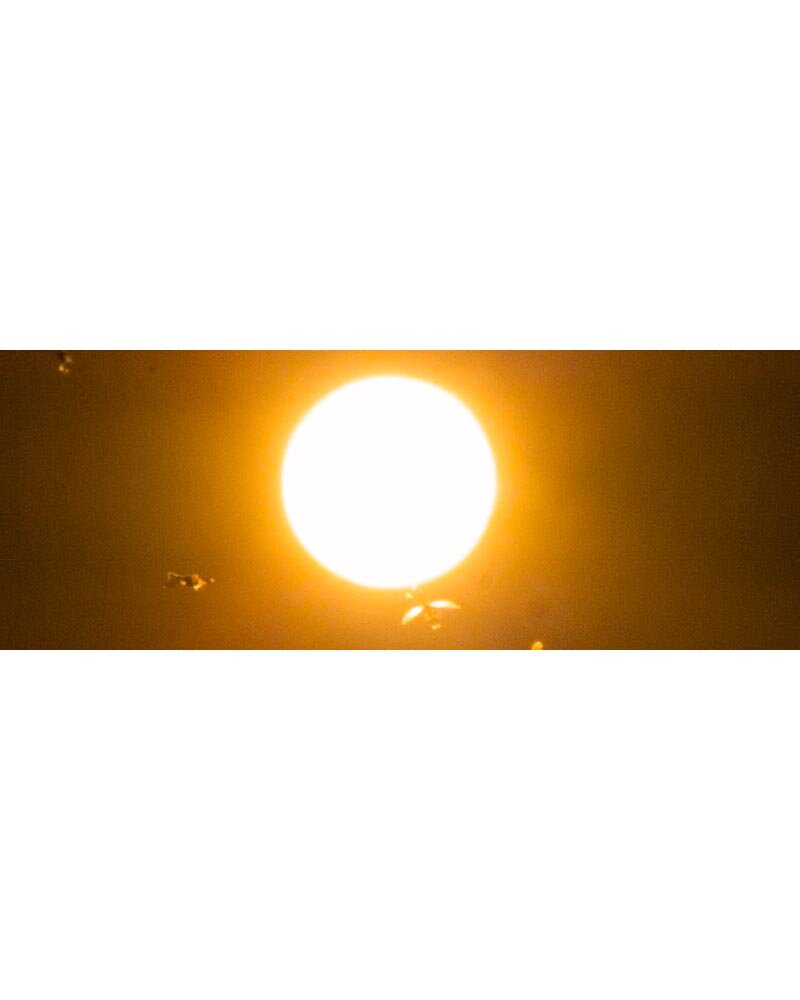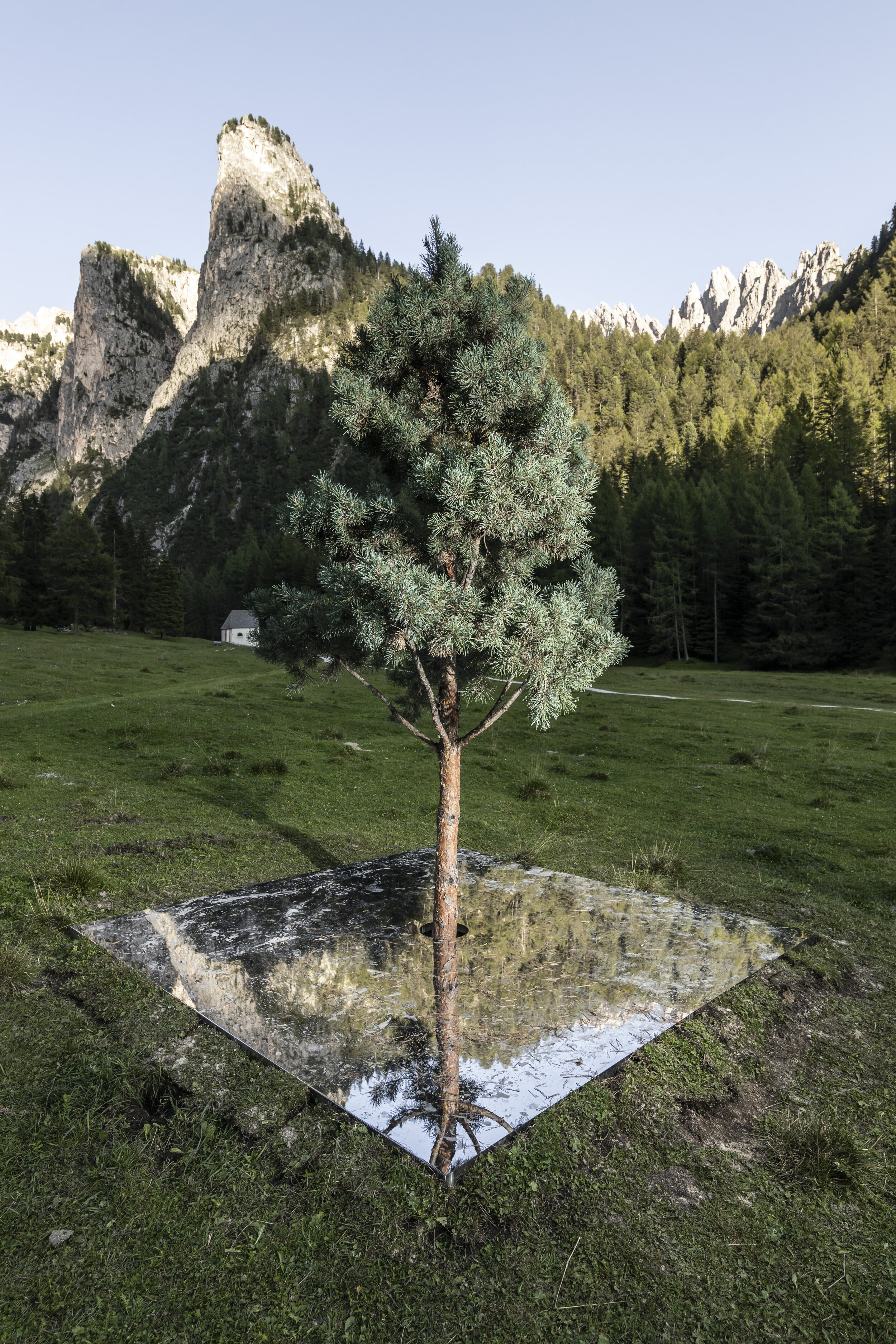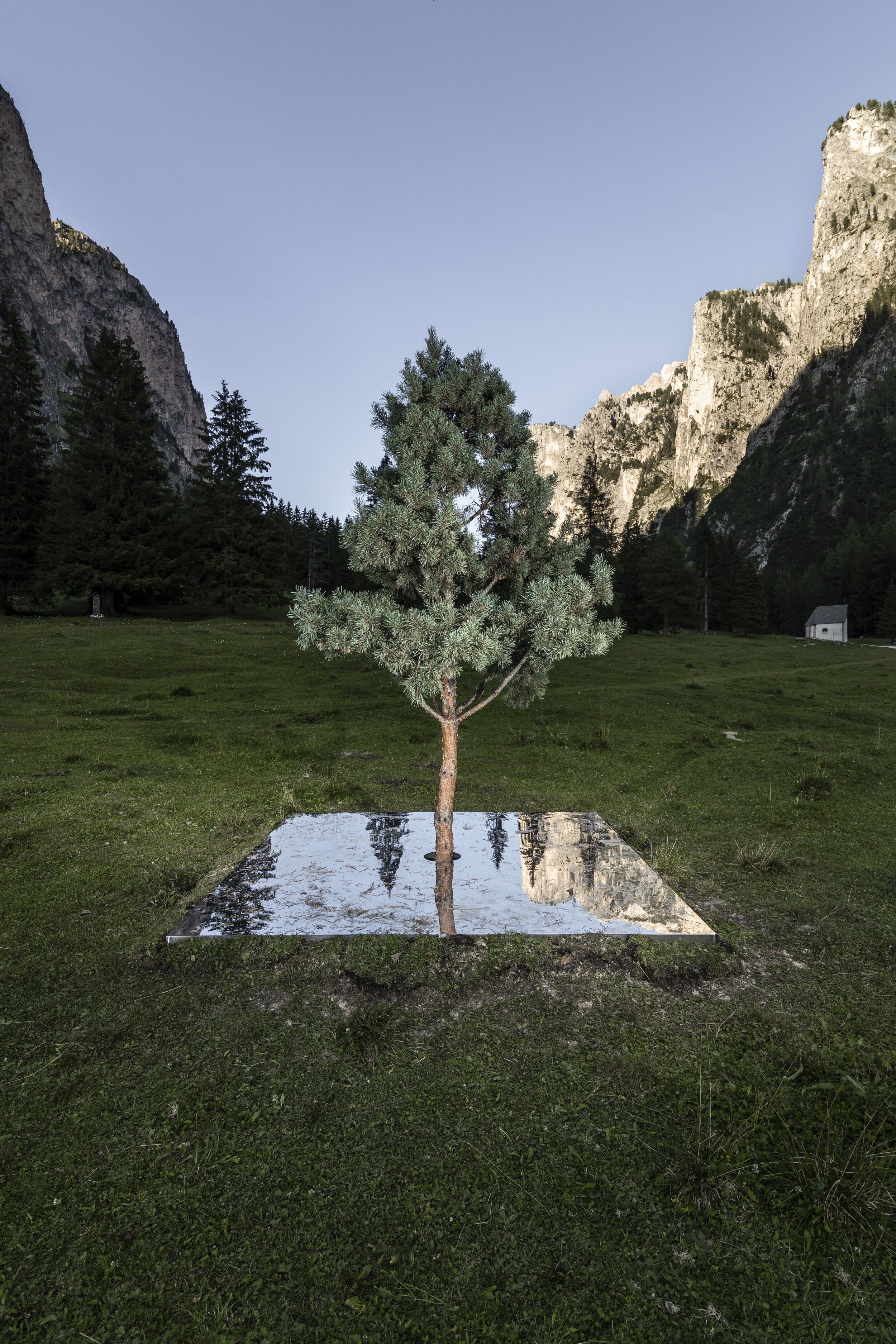
Henrik Håkansson
*1966, Sweden
lives and works in Falkenberg, Sweden and Berlin, Germany
EN
Henrik Håkansson (*1966, Sweden) studies natural cycles and in his artistic practice he is particularly concerned with the perception of changes in an ecological context. His projects often seek to make the connection between man, nature and environment visible, thus raising the spectator’s awareness of processes that are no longer perceived.
For the Biennale Gherdëina 7, Håkansson has developed a new project specially devised for installation in a precise place: it consists of a polished metal plate sitting like a square base around a solitary tree in the local landscape, placing nature and technology together on the same pictorial plane. The glossy surface of the plate reflects the landscape and the sky, thus enabling the spectator to observe nature in changeable conditions. The tree thus becomes an observation point and makes it possible to catch a sight of things that would not be perceivable in normal circumstances. At the same time, the mirror captures the image of the observers themselves, making them conscious of being part, not only symbolically but also physically, of nature, whose flowering or decline are directly correlated to their own existence.
By presenting certain natural phenomena in a new context, such as an exhibition space, Håkansson enables the viewer to become a critical observer. In his video work JUNE 22, 2020 203943 (Culicidae sp.), Henrik Håkansson observes repetitions and patterns created by the flight of the mosquito, which is often considered a parasite. The film was shot during the time of the sun going down, on June 22, at 8:39 pm, near Berlin. The video forms part of a series of films created in the context of an ongoing research project in which time fragments are caught with the help of a high-speed camera in various resolutions and speeds that document mostly arbitrary activities and movements of flying insects in different surroundings. These series may be regarded as screen tests, in reference to Andy Warhol’s idea of film portraits, in which time and date are set in relation to the artistic practice according to On Kawara’s concepts of time and being. Håkansson’s works work as a subtle dialogue between man, nature and space, and reflect not only the common system of values, but also man’s intervention in the sensitive balance of natural processes.
IT
Henrik Håkansson (*1966, Svezia) studia i cicli naturali e nella sua pratica si occupa in particolare della percezione dei cambiamenti nel contesto ecologico. I progetti di Håkansson sono spesso volti a rendere visibile la connessione tra l’uomo, la natura e il suo ambiente e a sensibilizzare lo spettatore a processi di cui non ci si accorge più.
Per la Biennale Gherdëina 7, Håkansson ha realizzato un nuovo progetto pensato appositamente per il contesto in cui è stato installato: una piastra metallica lucidata a specchio, adagiata su una base quadrata attorno ad un albero, che si erge solitaria nel paesaggio circostante. La superficie lucida della lastra riflette il paesaggio e il cielo, consentendo allo spettatore di osservare la natura da un punto di vista mutevole. L’albero diventa così un punto di osservazione e permette di vedere le cose in un modo che non sarebbe stato possibile in condizioni normali. Allo stesso tempo, lo specchio cattura l’immagine dell’osservatore stesso, rendendolo consapevole di essere parte, non solo sul piano simbolico ma anche fisicamente, della natura, la cui fioritura o decadenza sono direttamente correlate alla propria esistenza.
Alcuni fenomeni naturali in un nuovo contesto come ad esempio lo spazio espositivo, Håkansson permette allo spettatore di diventare un osservatore critico. Nel suo lavoro video “JUNE 22, 2020 203943 (Culicidae sp.)”, l’artista ha osservato i modelli di comportamento dello sciame di una specie di zanzara non definita (Culicidae sp.), spesso considerata un parassita. Il film è stato girato al tramonto del 22 giugno alle 20:39:43 vicino a Berlino, in Germania. Il video fa parte di una serie di filmati di un progetto di ricerca in corso, in cui frammenti di tempo vengono catturati con una telecamera in diverse risoluzioni e velocità, documentando per lo più attività e movimenti casuali di insetti volanti in ambienti diversi. Queste serie possono essere viste come dei provini basati sull’idea di Warhol di ritratto cinematografico, in cui tempo e data sono fissati in relazione alla pratica artistica di On Kawara e delle sue idee sul tempo e sull’essere.
Le opere di Håkansson funzionano come un sottile dialogo tra uomo, natura e spazio e riflettono non solo il sistema di valori comuni, ma anche l’intervento dell’uomo nel delicato equilibrio dei processi naturali.
DE
Henrik Håkansson (*1966, Schweden) studiert Naturzyklen und beschäftigt sich in seiner künstlerischen Praxis besonders mit der Wahrnehmung von Veränderungen im ökologischen Kontext. In seinen Projekten geht es ihm vor allem darum, die Verbindung zwischen dem Menschen, der Natur und seiner Umwelt sichtbar zu machen, um dem Betrachter Prozesse bewusst zu machen, die er selbst nicht mehr wahrnimmt.
Für die Biennale Gherdëina 7 entwickelte Håkansson ein neue Arbeit, für deren Umsetzung ein spezifischer Ort ausgewählt wurde: das Projekt besteht aus einer polierten Metallplatte, die sich wie ein quadratischer Sockel um einen in der Landschaft für sich stehenden Baum legt, um Natur und Technik im gegenseitigen Spiegelbild zu einer gemeinsamen Wahrnehmung zu vereinen. Die glänzende Oberfläche der Platte reflektiert die Landschaft und den Himmel und ermöglicht dem Betrachter, die Natur unter wechselnden Bedingungen zu beobachten. Der Baum wird zu einem Beobachtungspunk, um Eindrücke zu gewinnen, die unter normalen Umständen nicht sichtbar wären. Gleichzeitig fängt der Spiegel selbst das Bild des Betrachters ein und macht ihm bewusst, nicht nur symbolisch, sondern auch physisch Teil der Natur zu sein, deren Blüte oder Niedergang in direktem Zusammenhang mit seiner eigenen Existenz steht.
Indem er bestimmte Naturphänomene in einem neuen Kontext, wie z.B. in einem Ausstellungsraum, präsentiert, ermöglicht es Håkansson dem Betrachter, zum kritischen Beobachter zu werden. In seiner Videoarbeit „JUNE 22, 2020 203943 (Culicidae sp.)” beobachtete Henrik Håkansson Wiederholungen und Muster des Schwarmverhaltens einer nicht definierten Mückenart (Culicidae sp.), welche oft als Schädling betrachtet wird. Der Film wurde zur Zeit des Sonnenuntergangs am 22. Juni um 20:39:43 Uhr in der Nähe von Berlin, Deutschland, gefilmt. Das Video gehört zu einer Reihe von Filmen im Rahmen einer laufenden Forschung, bei der Zeitfragmente mit einer Hochgeschwindigkeitskamera in verschiedenen Auflösungen und Geschwindigkeiten eingefangen werden, die meist zufällige Aktivitäten und Bewegungen von fliegenden Insekten in verschiedenen Umgebungen dokumentieren. Diese Serien können als Screentests in Anlehnung an Warhols Idee von Filmporträts gesehen werden, bei denen Zeit und Datum in Bezug auf die künstlerische Praxis der On Kawara-Ideen von Zeit und Sein gesetzt werden. Håkanssons Arbeiten funktionieren als subtiler Dialog zwischen Mensch, Natur und Raum, und reflektieren nicht nur das gängige Wertesystem, sondern auch das Eingreifen des Menschen in das sensible Gleichgewicht von Naturprozessen.


